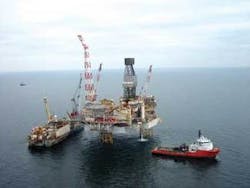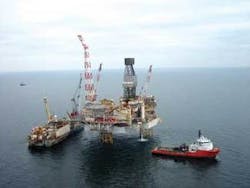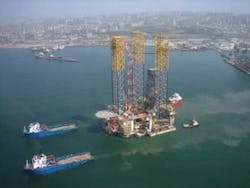Shah Deniz in full flow following complex platform set-down
Production is building at Shah Deniz in the Azeri sector of the Caspian. Under the first phase of the BP-operated development, nine wells will deliver up to 900 MMscf/d of gas and 58,000 b/d of condensate. All production is being exported through parallel sea lines to a terminal in Sangachal, on the shore of Azerbaijan.
The wells are being drilled from a three-legged TPG 500 jackup platform, supplied and installed by the project’s main engineering contractor, Technip. Shah Deniz is the third application of this proprietary design, the forerunners being BP’s Harding and Total’s Elgin/Franklin in the North Sea.
BP first engaged Technip for engineering studies in 1999, shortly after discovering Shah Deniz, 100 km (62.14 mi) offshore Baku. The focus at that stage was on the problematic seabed soil and seismic conditions, and the impact these might have on the dynamics of the platform.
Two years later, BP awarded Technip front end engineering design and detailed engineering studies. Following approval for the offshore pipeline route and more controversial onward routing across southern Georgia for the gas, the partners eventually sanctioned development in June 2003.
BP’s selection of a TPG 500 drilling, production and living quarters facility was driven in part by favorable experiences at Harding in the late 1990s - here the platform was delivered on time, and began drilling within a week of the installation, according to Technip’s Senior Vice President, Offshore Technologies, Pierre-Armand Thomas. But the Shah Deniz partners were also mindful of fabrication constraints in the Baku area, with the main yards virtually committed to the concurrent ACG Phase 2 development.
The TPG design, however, allows for fabrication in sections, which can be brought together later on for final assembly at one site.
This meant that the bulk of Shah Deniz’s platform construction work could be managed initially by a yard outside the Caspian Sea, before being imported via the usual canal and overland transport routes. Another benefit of the concept in this land-locked region is that it does not entail heavy lifts offshore, nor is there a need for large-scale logistics, beyond the use of tugs to tow the platform to its offshore location.
BP contracted Keppel FELS in Singapore for the platform’s 22,400 tonne (24,691 ton) hull, along with three wellhead modules and two production manifolds. Nymo in Norway was awarded the 2,200 tonne (2,425 ton) drilling module and derrick, designed by KCA Deutag in Aberdeen. In total, companies from 28 countries supplied materials and equipment for this project.
Technip Maritime Overseas was responsible for transporting these items in packages for subsequent assembly at Keppel FELS’ floating dock in Baku, and at the Socar-owned Zykh yard outside Baku. It also recruited and trained local personnel, which resulted in Zykh completing assembly of the three 135 m (442.91 ft) long jack-up legs (all pre-fabricated by Technip and French company Industeel), the supporting spud cans, the 120-man living quarters, and the flare boom. At peak, 3,600 people were employed on site for this project.
With a total weight of around 33,000 tonnes (36,376 tons), the completed platform is lighter than the TPG 500 at Elgin/Franklin, but heavier than Harding’s. In terms of the topsides, says Thomas, “the main differences to what we did before are the rather sophisticated, automated, 15,000 psi drillfloor equipment, to manage flow from the high pressure wells (7-800 bar). We have designed the production facilities to withstand 850 bar, including the two production manifolds, valves and separation equipment.”
The overall jet fire design extends to the living quarters module, which is equipped with blast walls. It has been positioned well away from the well bay, which is itself enclosed by a blast wall.
“The pigging system is relatively sophisticated,” Thomas adds, “but otherwise the process equipment is pretty light, with two 15 m (49.21 ft) high separators providing one-stage separation.”
The platform has been installed over a 15-slot drilling template. Four of the wells were pre-drilled prior to the field coming onstream last December. After phase 1 is completed, the platform will have six spare conductor slots, so this may allow the platform to serve as a hub for future discoveries in the area.
Inward shipment
By October 2004, all main sections of the hull, drilling, and wellhead modules built outside Azerbaijan were in Baku. Following transportation onboard theMighty Servant III, the seven packages built in Singapore had been transferred onto barges for onward shipment through the Volga Don canal system from the Black Sea. The drilling equipment came in from the northern entrance to the Caspian Sea, via the Baltic-Volga waterways.
“This was not a simple task,” Thomas points out, “in part because of the need to maintain water-tightness of the pre-fabricated hull strips while in transit. To do this, we had to install double bulkheads in the hull design. Also, the weather was freezing for the journey through the Caspian, although we had organized our logistics to take that into account.”
Following welding of the strips at the Keppel FELS-owned floating dock in Baku, the assembled platform was towed to Zykh in March 2005 for hook-up, including pipework connections.
Technip had trained 20 welders to manage Zykh’s Legs pre-fabrication work. “Our main concern had been the jackup legs, which would involve welding the highest grade of steel available with the highest tolerances. Our training program turned out to be a good move, resulting in a very low repair rate. But the design of the TPG 500 legs was also favorable in that regard, calling for the same diameters for the bracings, with the same nodes everywhere. This made for repetitive welding procedures, which in turn made the training easier.”
More major problems lay ahead, however, due to seabed conditions at the set-down location. According to Thomas, “although the 4-m [13.12 ft] deep sand layer on top provided reasonable resistance, the burden was the 2 m [6.56 ft] of soft clay underneath, with below that more sand. We would have to penetrate this third layer of sand by up to 2 m [6.56 ft].
“At the same time, we also had to contend with a 1% gradient slope, and varying thickness of the clay. Our chief preoccupation concern was resistance. We didn’t know what we would encounter, so we had to devise an installation procedure to cover all hypotheses.”
Elgin Franklin’s jackup was fixed to the seabed by means of fairly small, temporary spud can piles at the base of each leg. Shah Deniz’s conditions dictated the need for much larger spud cans - 12 m (39.37 ft) high, and 30.48 m (100 ft) in diameter, 1,200 tonnes (1,322 tons) - driven deep into the seabed to provide a stable foundation for the platform.
Unfortunately, the shallow draft at Zykh ruled out mating of the spud cans to the bottom of the legs at the quayside. This forced the joint BP/Technip project team to devise an alternative connection procedure at a designated offshore site prior to installing the platform above the drilling template.
Each can comprised a 4-m (13.12 ft) high upper section housing ballast tanks for controlling ascent or descent in water, and an 8-m (26.24 ft) deep bottom section, with ballast pumps on top of the cans, along with a locking mechanism providing attachment to the legs. All the cans had also been reinforced by a concrete grout base. The plan was to tow them 70 km (43.5 mi) to an offshore “parking” station, ahead of their eventual mating with the TPG 500 jackup legs.
To prevent the cans capsizing en route, Technip designed a supporting U-shaped “cradle” 30 m (98.42 ft) long and 45 m (147.63 ft) wide, surrounded by three 15-m (49.21 ft) high flotation tanks. This 600 tonne structure was built at the Bos Shelf SPS construction yard near Baku.
As Zykh lacked the lifting capacity to place the cans within the cradle, Technip decided to strengthen the quayside with 40-m long piles and concrete coverings to support a temporary crane. The 2,500-tonne (2,755 ton) lift vesselMammoet MSG 50 was brought across for this purpose, via rail containers.
In March 2006, following re-assembly at Zykh, the crane lifted the first of the cans into the cradle. Once the can had been clamped to the flotation tanks, it was towed at a draft of 5.5 m (18 ft) to the parking site. On arrival, the clamps were released, allowing the can to float free. Following deballasting, the cradle and its tanks were towed back to Zykh to repeat the process for the remaining cans.
The fully commissioned platform left Zykh in mid-April 2006 for mating with the cans at a pre-arranged mooring location. The team had hoped for fair weather for the 19-day tow-out, but in fact they were subjected to a 50-year return-period storm, followed by a less severe storm. No damage resulted, although at one point there was a 5.5-m (18 ft) significant wave surge between two of the spud cans, one of which was already connected to the sea floor.
After the platform had been moored in 70 m (229.65 ft) of water, the cans were also brought to the site, and connected one by one to the base of the jackup legs via three control lines. They were then lowered into the water using a technique devised by Technip to prevent damage to the lines on the way down.
This operation, controlled from the jackup, involved ballasting the cans so that they descended through the water in a regulated, pendulum motion before settling a short distance below the platform leg. The latter was then itself lowered to achieve connection to the can, before being retracted to the platform, ahead of the 15-km (9.32 mi) journey to its installation site.
For this final operation, the platform was first secured in position above the drilling template by four anchored vessels. The legs were then slowly deployed to the seabed, the penetration speed of the spud cans being controlled to avoid punch-through while traversing the soft clay strata. When the three legs had been secured, the hull was jacked up to a position 5.5 m (18.04 ft) above the water line.
Once penetration had been completed, and further quantities of concrete grout added to secure the foundations, the platform was jacked up to its final operating height of 13.5 m (44.29 ft) above the sea surface.
According to Thomas, Shah Deniz employed the same basic jacking system as in the previous two projects, although slightly more powerful. However, this one features only 72 pinions, compared with 90 on Harding’s system - even though the topsides load is heavier.
“We managed this by improving certain characteristics, such as metallurgy,” Thomas said.
For this project, Technip and BP had an integrated team. “Some parts of the contract had to be managed by BP alone,” Thomas points out, “particularly when it came to liaising with local authorities in Azerbaijan. Otherwise, we supervised the project initially from Paris, before part of the team moved to Baku to manage the fabrication. We also brought together a dedicated team for the mating operation.
“In the end, the field produced first gas at the originally designated date of December 2006, so despite all the difficulties we encountered along the way, we are very pleased with the outcome. Our training program at Zykh also proved to be worthwhile. I was reluctant at first to have the legs assembled in Baku, but it went very well.”
Technip continues to promote the TPG 500 concept in the North Sea and other parts of the world, including the Gulf of Mexico, Venezuela, West Africa, and the Asia-Pacific region. One option under review is a reusable version that could switch between marginal fields following relatively short periods of production.


